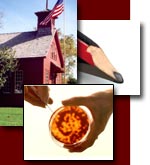| Site Map | Contacts | Links | Newsletter | |
Homeschool:
Linguistics
The study of human speech (language).
Definitions
Language - a spoken, symbolic, and learned system of communication among human beings.
Phonological - sound change.
Phoneme - the smallest unit of sound in a language.
Morphological - form change.
Morpheme - is the smallest unit of meaning in a language.
Allomorph - a phonemic variation of a morpheme.
- Bases - root words.
- Affixes - stuck on.
- Prefixes - before the root.
- Suffixes - after the root.
Syntactical - arrangement change.
Grammar 0 - is the set of universals that all natural languages share.
Grammar I - is the set of rules that accounts for the way any given language works.
Grammar II - is one of a group of descriptions of those rules.
Grammar III - is a study of one or more of these descriptions.
Grammar IV - is a set of etiquette rules for acceptable writing and speaking.
Semantics - the study of the meaning of words and forms.
Lexicon - is the inventory of morphemes (words) with their meanings.
Syntax - the system which joins morphs into sense-making units.
Dialect - a version of a language distinct from another version of the same language.
Isogloss - a term referring to the geographic boundary of a linguistic trait like a southern accent.
History of Linguistics
Noam Chomsky wrote the book "Syntactic Structures" in 1957. In 1965 he wrote "Aspects of a Theory of Syntax." Chomsky asserts that rationalism is the bases of his grammar, and he assumes that there is a universal language. He is against American structuralism or Bloomfieldian which is based on empirical data. Chomsky defines grammar as a set of rules for generating all the grammatical sentences of a language. He is known for TG- Transformational Grammar. He saw deep structure, and surface structures in sentences.
